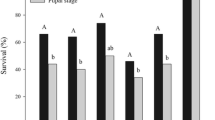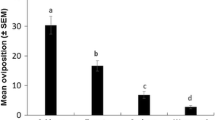Abstract
Experiments were conducted in a rearing room to study the biology ofTrichogrammatoidea simmondsi Nagaraja (Hym.: Trichogrammatidae) on sorghum shoot fly,Atherigona soccata Rondani (Dipt.: Muscidae) eggs. Shoot fly eggs were divided in two groups: 1) eggs < 24 h old and, 2) > 24 h old eggs. Thirty eggs of each group were used in a randomized complete block design with four replicates. Shoot fly eggs less than 24 h old were preferred (73% of parasitism) over 24 h old eggs (7.25%). Three larval instars ofT. simmondsi were observed. Few eggs with twoT. simmondsi exit holes (1.87%) were recorded in > 24 h old eggs compared with < 24 h ones (3.74%). The sex ratio male: female was 1 ∶ 1.47. The development from oviposition to adult emergence ranged from 7 to 12 days (average=9.8±1.31, n=40), and the average life span of male and femaleT. simmondsi was 25±1.46 h (range 22–26 h, n=12) and 35.17±10.9 (range 25–50 h, n=28) respectively at 26° C, 60–65% R.H. and 12 ∶ 12 (L/D) photoperiod. This paper constitutes the first published information on the biology ofT. simmondsi on the sorghum shoot fly eggs.
Résumé
Des essais ont été conduits en salle d'élevage en vue d'étudier la biologie deTrichogrammatoidea simmondsi Nagaraja (Hym.: Trichogrammatidae) sur les œufs de la mouche des pousses du sorgho,Atherigoa soccata Rondani (Dipt.: Muscidae). Les œufs de la mouche ont été divisés en deux groupes: 1) ℧ufs âgés de < 24 h, 2) > 24 h. Trente œufs de chaque groupe ont été utilisés dans un dispositif en blocs complets randomisés à quatre répétitions. Les œufs de moins de 24 h d'âge ont été plus parasités (73% de parasitisme) que ceux de plus de 24 h d'âge (7,25% de parasitisme). Trois stades larvaires deT. simmondsi ont été observés. La présence de deux trous d'émergence deT. simmondsi était moins élevée (1,87%) dans les œufs de > 24 h que dans ceux de < 24 h (3,74%). Le sex ratio mâle: femelle était de 1 ∶ 1,47 Le cycle de développement de l'œuf à l'émergence de l'adulte variait de 7 à 12 jours avec une moyenne de 9,8±1,31 (n=40). La durée moyenne de vie du mâle et de la femelle deT. simmondsi était respectivement de 25±1,46 h (variation 22–26 h, n=12) et 35,17±10,9 (variation 25–50 h, n=28) à 26°C, 60–65% H.R. et une photopériode de 12 ∶ 12. Cet article constitue la première information publiée sur la biologie deT. simmondsi sur les œufs de la mouche des pousses du sorgho.
Similar content being viewed by others
References
Abacus Concepts Inc. — 1989. SuperANOVA, accessible general linear modeling. —Berkeley, CA, 316 p.
Deeming, J. C. — 1971. Some species ofAtherigona Rondani (Diptera: Muscidae) from Northern Nigeria, with special reference to those injurious to creal crops. —Bull. Entomol. Res., 61. 133–190.
Feijen, H. R. &Schulten, G. G. M. — 1981. Egg parasitoids (Hymenoptera; Trichogrammatidae) ofDiopsis macrophthalma (Diptera; Diopsidae) in Malawi. —Neth. J. Zool., 31, 381–417.
Jacques, J. M., van Alphen &Visser, M. E. — 1990. Superparasitism as an adaptive strategy for insect parasitoids. —Annu. Rev. Entomol., 35, 59–79.
Jones, R. L. — 1981. Chemistry of semiochemical involved in parasitoid-host and predator-prey relationships. In: Semiochemicals, their role in pest control (Nordlund, D. A., Jones, R. L. &Lewis, W. J., eds.). —John Wiley & Sons New York, 239–250.
Nagarkatti, S. &Nagaraja, H. — 1977. Biosystematics ofTrichogramma and Trichogrammatoidea species —Annu. Rev. Entomol. 22, 157–176.
Pintureau, B. &Babault, M. — 1988. Systématique des espèces africaines des genresTrichogramma Westwood etTrichogrammatoidea Girault (Hym. Trichogrammatidae). —Les colloques de l'INRA, 43, 97–120.
Raina, A. K. — 1991a. Movement, feeding behaviour and growth of larvae of the sorghum shoot fly,Atherigona soccata. —Insect Sci. Applic., 2, 77–81.
Raina, A. K. — 1981b. Deterrence of repeated oviposition in sorghum shoot fly,Atherigona soccata. —J. Chem. Ecol., 7, 785–790.
Singh, P., Unnithan, G. C. &Delobel, A. G. L. — 1983. An artificial dier for sorghum shoot fly larvae. —Entomol. exp. appl., 33, 122–124.
Soto, P. E. — 1972. Mass rearing of the sorghum shoot fly and screening for host plant resistance under greenhouse conditions. In. Control of sorghum shot fly (Jotwani, M. G. &Young, W. R. eds.) —Oxford & IBH New Delhi, 137–146.
Stehr, F. W. — 1982. Parasitoids and predators in pest management. In: Introduction to insect pest management (Metcalf, R. L. &Luckmann, W. H., eds.). —John Wiley & Sons, New York, 135–173.
Stinner, R. E. — 1977. Efficacy of inundative releases. —Annu. Rev. Entomol., 22 515–531.
Takahashi, F. &Pimentel, D. — 1967. Wasp preference for black-brown and hybrid-type pupae of the house fly. —Ann. Entomol. Soc. Am., 60, 623–625.
Taylor, A. D. — 1988. Parasitoid competition and the dynamics of host-parasitoid models. —Am. Nat., 132, 417–436.
Vet, L. E. M. &Dicke, M. — 1992. Ecology of infochemical use by natural ennemies in a tritrophic context. —Annu. Rev. Entomol., 37, 141–172.
Vinson, S. B. — 1985. The behavior of parasitoids. In: Comprehensive Insect Physiology Biochemistry and Pharmacology, Vol. 9, Behaviour (Kerkut, G. A. &Gilbert, L. I., eds.). —Pergamon Press New York, 417–469.
Waage, J. — 1986. Family planning in parasitoids: Adaptive patterns of progeny and sex allocation. In: Insect parasitoids (Waage, J. &Greathed, D., eds). —Academic Press, London, 63–95.
Zongo, J. O., Vincent, C. & Stewart, R. K. — 1993. Time-sequential sampling of the sorghum shoot fly,Atherigona soccata Rondani (Diptera: Muscidae), in Burkina Faso.Insect Sci. Applic (in press).
Zongo, J. O., Vincent, C. &Stewart, R. K. — 1993. Effects of Intercropping Sorghum-Cowpea on Natural Enemies of the Sorghum Shoot Fly,Atherigona soccata Rondani (Diptera: Muscidae) in Burkina Faso. —Biol. Agric. & Hort, 9, 201–213.
Author information
Authors and Affiliations
Rights and permissions
About this article
Cite this article
Zongo, J.O., Vincent, C. & Stewart, R.K. Biology ofTrichogrammatoidea simmondsi (Hym.: Trichogrammatidae) on sorghum shoot fly,Atherigona soccata (Dipt.: Muscidae) eggs. Entomophaga 38, 267–272 (1993). https://doi.org/10.1007/BF02372562
Received:
Accepted:
Issue Date:
DOI: https://doi.org/10.1007/BF02372562




